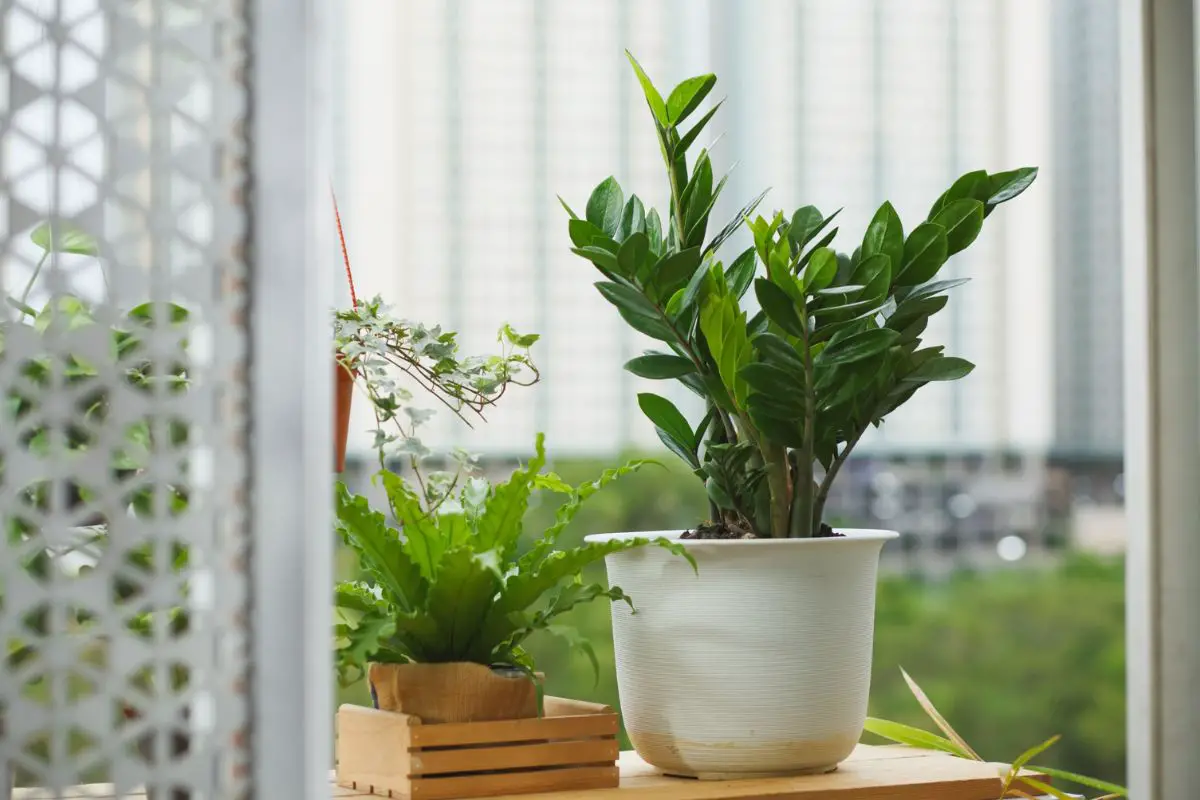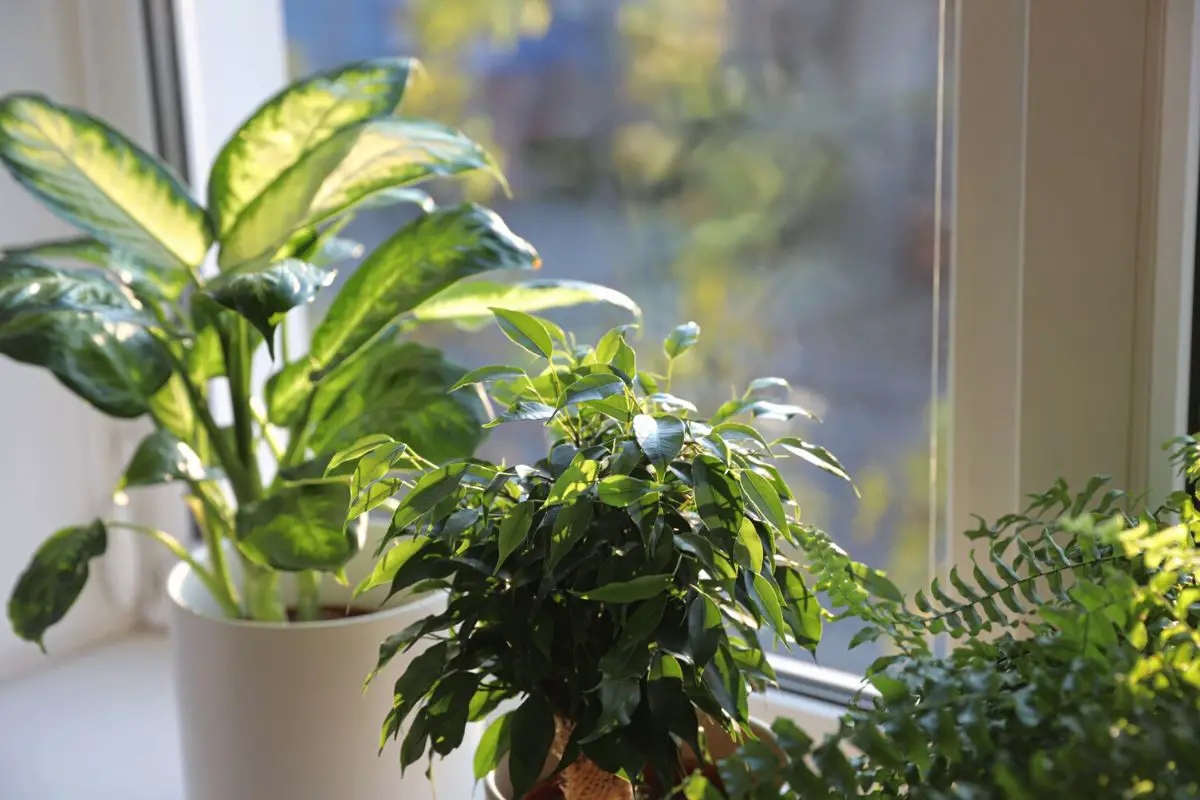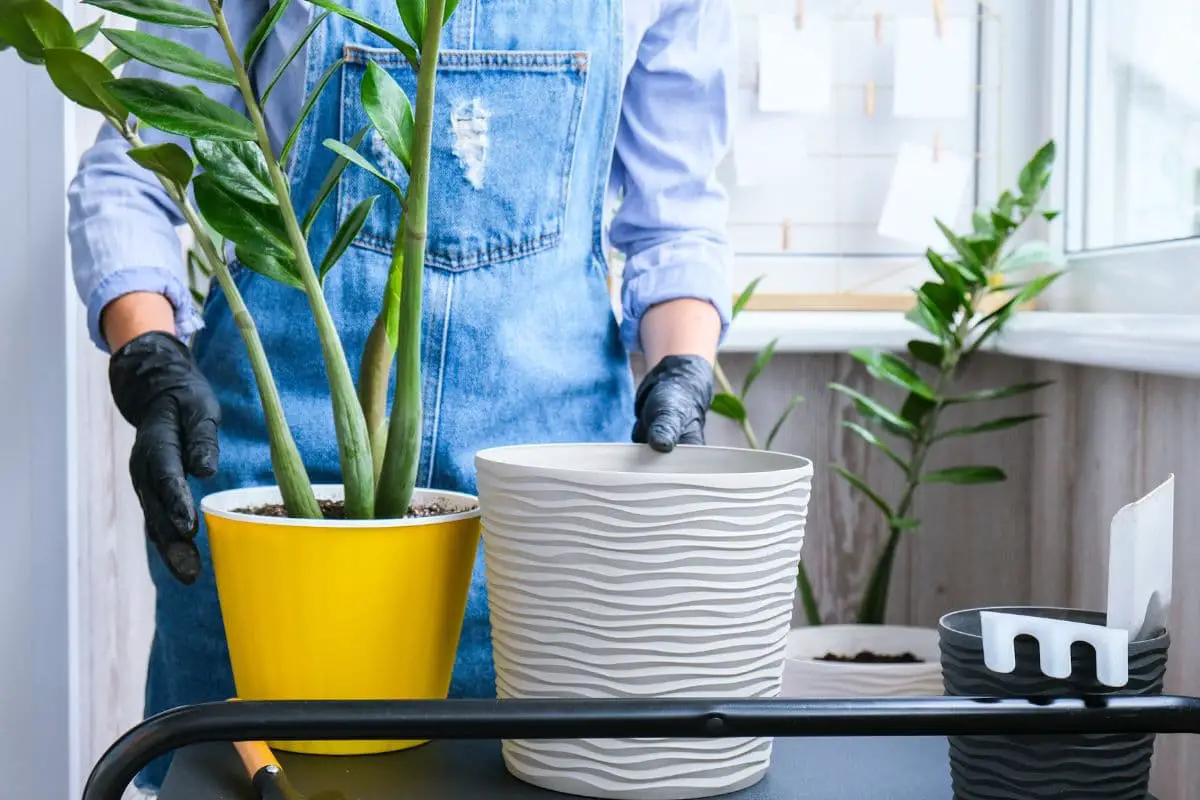ZZ plants (Zamioculcas zamiifolia) have perky, green leaves that can remain vibrant for up to six months, even with minimal care. Their lovely foliage and low-maintenance needs make them popular indoor plants. However, failure to provide proper care can cause ZZ plants to droop.
ZZ plants may droop or wilt due to the following issues:
- Underwatering
- Overwatering
- Lighting issues
- Improper Temperatures
- Pest infestations
- Nutrient imbalances
In this article, I’ll explore how these issues can influence your ZZ plant’s appearance. I’ll also share some practical tips on how to prevent or fix them to keep your plant’s foliage looking its best.

ZZ Plants: An Overview
ZZ plants are native to warm tropical regions of East and South Africa. Here are the environmental conditions in their native habitat:
- They grow in loose, sandy soil.
- They reach only 2-4 feet (0.6-1.2 m) tall and wide and receive dappled shade from taller canopies around them.
- The wet season in their native habitat begins in November, but wild ZZ plants receive sufficient rainfall only for 3 months a year, typically from March to May. It’s then followed by a dry season with sporadic and shallow rains for half the year.
- Moderate temperatures and humidity facilitate moderate metabolic activities leading to slow growth.
Because of the abovementioned environmental conditions, ZZ plants have developed succulent and turgid stems that keep them upright. The leaves also have a waxy coating that keeps them hydrated for longer.
Wild plants are more likely to droop or wilt due to irregular rains, drastic temperature fluctuations, and unexpected bad weather conditions.
On the other hand, when kept indoors at moderate light, temperature, and humidity, individual stems with green leaves can last 2-6 months. Even with age, they remain upright, and you’ll only know it’s time to prune them when the leaves start turning yellow.
Symptoms of Drooping or Wilting
Some outermost stalks naturally lean outward when the ZZ plant becomes crowded in its pot. As a result, you might notice right away that your plant is drooping.
Here are some symptoms that will help you determine whether the drooping (and wilting) is due to plant care and health issues:
- Limp or drooping stalks: ZZ stems or stalks may hang limp or bend towards the floor only when the plant is unhealthy. Under normal conditions, the stalks stand upright due to the turgidity in their thick walls.
- Wilting: Leaves lose their stiffness and firm texture, which only happens when the plant is stressed.
- Drooping leaves: Healthy leaves point upwards, typically at an angle of 30-60°. The angle gradually increases to 80-90° as the stems age. In rare cases of severe drought, individual leaves may droop further outward or downward.
Below are additional signs to help you identify the root cause:
- Yellow leaf tips
- Brown and crisp leaf tips or edges
- Yellowing of the entire leaf surface
- Brown, mushy spots on the leaves
- Wrinkly or curling leaves
- Legginess and sparse leaves
- Brown, scorched spots over the leaf surface
- Leaf holes
- Brown spots or bumps along the stems
- Stunted growth
I recommend checking your plant a few hours after watering to see if it perks up when fully rehydrated. This is also a good time to look for pests potentially hiding underneath the leaves or along the stems.
Common Causes (& Fixes)
Here are the common causes of drooping and wilting in ZZ plants:
Underwatering
ZZ plants are famous for their drought tolerance, so it may come as a surprise that they’ll droop due to underwatering. I, for one, have gone up to 2 months without watering my plants, and they showed little to no signs of stress.
ZZ plants handle drought better under the following conditions:
- Low light conditions (i.e., in front of a northern window or under artificial lights)
- Moderate temperatures ranging from 65-75 °F (18-24 °C)
- Periods of slower growth (fall and winter)
When you increase the watering frequency in early spring to prompt a growth spurt in your plant, it’s important to maintain a more regular watering routine. Watering your plant every 2-3 weeks in spring and 10-14 days in the summer should be enough.
Suddenly exposing your plant to drought while it’s actively growing will increase the risk of drooping or wilting because they can’t automatically slow down their metabolic activities.
You can single out this root cause with the following considerations and additional symptoms:
- The plant is in medium to high light conditions, such as bright indirect light all day or with over 2 hours of direct sunlight
- The temperature is constantly around 80 °F (27 °C)
- Yellowing leaf tips that turn brown and crisp
- Wrinkly or curling leaves
- Dry and crusty soil with cracks, indicating hydrophobicity due to frequent underwatering
- Stunted growth
You can fix the problem by increasing your watering frequency accordingly. Inspect the soil moisture more often and water your plant when the upper half of the potting mix feels dry. Don’t wait until it dries out entirely so your plant can recover more quickly.
If the soil has become hydrophobic, you can dunk the pot in water until it’s fully rehydrated. In severe cases, you may need to repot your ZZ plant in fresh soil rich in organic matter for better moisture retention.

Overwatering
ZZ plants are susceptible to root rot when kept in constantly wet soil. The roots and bulbs are sensitive to excess moisture and will decay if you water your plant too often. The rot-causing pathogens can spread to the stems, and the decayed section will cause them to bend.
You can distinguish overwatering as the root cause with the following signs:
- The soil surface remains wet or soggy three days after watering. This indicates poor water infiltration and drainage.
- Entire leaf surfaces turn yellow
- Brown, squishy spots on the leaves
- Smelly roots
- Black, mushy roots and bulbs
When the ZZ plant droops or wilts due to overwatering, it means the issue has progressed too far and you can’t revive your plant.
Instead, you can propagate it using the remaining healthy leaves at the terminal end of the stems.
Prevent this issue from affecting your plants in the future with the following tips:
- Use a loose, fast-draining soil mix to prevent waterlogging. I recommend using a standard succulent mix or a homemade compost-perlite mix.
- Check the soil moisture to confirm the upper half is completely dry before watering enough to saturate the dry layer.
- Reduce the watering frequency to once every 4-6 weeks by midfall until winter to mimic the dry period in their native habitat and give your plant renewed energy in spring.
Light Issues
ZZ plants look their best when they receive bright, indirect light for at least 8 hours daily. Under this condition, they develop a darker emerald hue, which is pretty attractive.
Mature plants can will thrive under artificial lights for 10-12 hours a day or unobstructed light from a northern window during the day.
Here are some signs that your plant is unhappy with the light conditions:
Insufficient Light
Although ZZ plants are known for their tolerance to lower light conditions, they will become leggy when they receive insufficient light.
The dark-exposed stems will grow longer and lean toward the windows or light bulbs in your home. As the stems grow longer, the spaces between nodes also increase, resulting in sparse leaves that appear pale green or yellow.
The overgrown stems will then bend and droop to the grown, leaving your plant looking scraggly.
Excessive Sunlight
ZZ plants generally dislike direct sunlight, which can burn their leaves. In mild climates with moderate temperatures, they can tolerate up to two hours of direct sunlight as long as they’re well-watered.
When your plant is dehydrated and exposed to high-intensity sunlight, the sun-exposed leaves will develop scorch marks that can sometimes create holes. The dehydrated stalks and leaves will become limp and droopy.
The plant may also become leggy and lean away from the light source.
Fixes and Tips
You can fix the problem by pruning the leggy growth and damaged foliage. After which, move your plant to better lighting conditions.
Here are some tips to find the perfect balance for your ZZ plant:
- Find a spot in your home that receives bright, indirect light during the day. This could be a few feet (+1.2 m) away from an unobstructed eastern window.
- Place your plant next to an unobstructed northern window. Supplement the lighting during cloudy days with artificial light for 8-10 hours.
- Hang sheer curtains if you have west- or south-facing windows or move your plant farther away.
- Rotate your plant by 90-180° weekly or every time you water it to ensure even light distribution and growth.
If your room or office only has artificial light, ensure your plant receives light from a 40-watt fluorescent or LED lamp for 10-12 hours daily. Keep the lamp a foot (30 cm) above your plant with the light focused directly toward your ZZ plant.
Pro tip: Use a lamp stand with adjustable height so you can move the lamp accordingly as the plant grows taller.

Improper Temperatures
Extreme temperatures don’t directly cause drooping or wilting in ZZ plants. Instead, they’re secondary causes that can worsen the plant’s underlying health issues.
For instance, constantly high temperatures (over 85 °F or 29 °C) can worsen dehydration symptoms due to underwatering and sun stress. The stems and leaves can dry out more quickly and droop. Sometimes, the leaves may even curl up or appear wrinkly.
On the other hand, temperatures below 50 °F (10 °C) can cause cold shock to ZZ plants, causing the leaves and stems to droop.
Young ZZ plants and cuttings root better when kept at higher temperatures, around 90 °F (32 °C). They can handle such heat only because their substrate is usually kept consistently moist. However, mature plants have a lower tolerance to heat.
Here are the tips to fix and prevent temperature-related damage to ZZ plants:
- Prune drooping stems and damaged foliage.
- Keep your plant at moderate temperatures between 65 and 85 °F (18 and 29 °C).
- Monitor the soil moisture more frequently if your plant is in a warmer room. You may need to increase the watering frequency.
- Keep your plant away from cold drafts and cooling or heating vents to avoid temperature fluctuations.
- Reduce watering accordingly during colder months.
Pest Infestations
ZZ plants have a few pests, and they can hardly damage mature plants, which are famous for being sturdy.
Young plants, however, have lower resistance to pest damage, especially when stressed due to the poor environmental and care issues discussed above. In this case, a severe pest infestation can worsen the symptoms or even kill the plant.
Aphids, mealybugs, and scale mites feed on the sap of leaves and stems. In large populations, they can consume significant moisture from the already underwatered stems, causing them to droop or wilt.
You must address the other care issues while dealing with the pests.
You can manage pest populations or eliminate them from your indoor garden with the following tips:
- Check the underside of the leaves and along the stems because that’s where the pests hide.
- Look for brown, immobile bumps along the stems, indicative of scale mites. Aphids are translucent green, brown, or white insects. On the other hand, mealybugs form fluffy white clumps.
- Remove the pests using tweezers or cotton swabs dipped in alcohol. You may need to scrape the scale mites off the stalks because they adhere to the surface.
- Drop the pests in soapy water.
- Spray your plant with a neem oil solution once weekly until the pests are gone. If your plant is out of direct sunlight or in low light, spray in the morning. Alternatively, do it after sunset.
Do the same for the other houseplants sitting close to your ZZ plant to ensure the pests have nowhere to hide or escape to. This will effectively remove the problem from your indoor garden.
Moreover, isolate new plants for 8 weeks and address existing pest issues before moving them to your indoor garden. It’s important to avoid introducing pests to your other houseplants.
Nutrient Imbalances
ZZ plants need low to moderate nutrients because of their efficient food storage system. Excess fertilizer is often a bigger problem than insufficient nutrients, but both issues can cause drooping or wilting when left unaddressed.
Fertilizer Burn
Excess fertilizer salts in the soil mix can burn the ZZ plant roots and bulbs by draining their stored moisture. Underwatering, high temperatures, and intense sunlight can worsen this issue because the roots and bulbs will dry out more quickly.
As a result, the leaves and stems start to droop due to dehydration. You’ll also notice similar signs to underwatering, such as yellow leaf tips and brown, crisp edges.
You can fix this issue with the following tips:
- Move your plant a few feet (+ 0.6 m) away from the windows
- Scrape the visible film of fertilizer over the soil surface. You can remove ¼-½ inch (0.6-1.3 cm) of soil mix off the surface.
- Flush out the excess fertilizer by watering your plant with 3-4 times higher volume than usual. For instance, if you water a 1-gallon (3.8 l) pot with ½ gal (1.9 l) regularly, use 1.5-2 gal (5.7-7.6 l) to drain the excess fertilizer salts.
- Pour the water gradually, about half a gallon (1.9 l) at a time at 2-hour intervals.
- Leave the plant over a drip tray in the sink or tub the whole time to let the excess water drain freely.
If you use the appropriate soil mix (loose and fast-draining), flushing the soil once should be enough to leach excess nutrients and rehydrate the dried-out roots and bulbs.
Otherwise, you may need to repot your plant in fresh soil and avoid fertilizing it for a year.
Nutrient Deficiency
ZZ plants may need supplemental feedings when kept in the same pot for more than 2 years. Otherwise, they will droop or wilt.
The three primary plant nutrients (nitrogen, phosphorus, and potassium), also known as NPK, are crucial for shoot development and building sturdy cells.
A lack of these nutrients will result in weaker stems that are more susceptible to drooping and wilting from environmental stress.
You can confirm nutrient deficiency when you see yellowing in older leaves, which indicates a lack of nitrogen. You may also notice interveinal chlorosis (yellow leaf surface with green veins) due to iron deficiency.
You can fix the problem with the following tips:
- Within the growing season: Feed your plant with a half-strength liquid fertilizer. Choose a product with 10-10-10 NPK values and contains micronutrients like iron, magnesium, and manganese. Reapply after three weeks or at the next watering session.
- Outside of the growing season: Replenish the soil by topping up the soil mix with high-quality compost.
Pro tip: To prevent these issues, I use high-quality compost and mix it in equal parts with perlite to give my plant a gentle dose of nutrients. I apply slow-release 10-10-10 NPK fertilizer only once the following spring after repotting, and my plant has been thriving.
A larger plant (over two feet or 0.6 m) with multiple stems and bulbs may need more fertilizers to maintain the health and appearance of the foliage. In this case, I give my plant a second feeding in early summer.

Routine Care and Maintenance
ZZ plants require very minimal care, and it’s often easy to neglect them. Although they can tolerate suboptimal environments, constant neglect will lead to significant problems.
Here are some care and maintenance tips to ensure your plant keeps thriving:
- Water your plant regularly: A good rule of thumb is to water your plant once every 2-3 weeks in spring, every 10-14 days in summer, and every 4-6 weeks during the cold season.
- Inspect your plant regularly: This can be done weekly or every time you water your plant so you can catch, diagnose, and treat issues promptly.
- Maintain optimal lighting and temperatures: When light intensity and temperatures increase during summer, you can move your plant a few feet (+0.6 m) away from a bright window. On cloudy or darker winter days, give your plant supplemental lighting using artificial lights for eight hours a day.
- Repot your plant every 2-3 years: This will give your plant enough space to grow and replenish the soil with fresh nutrients. Use a loose soil mix and a pot only one size larger.
- Divide your plant every 3-5 years: It will help rejuvenate your old plant and give you small to full-sized plants.
Final Thoughts
ZZ plants are sturdy and tolerant of poor care or environmental conditions. However, they’re not immune to constant neglect and are likely to droop or wilt when kept in suboptimal conditions for extended periods.
Even the most resilient houseplants require attention and consistent care to maintain their overall health and appearance. It’s important to be attentive and proactive in your plant care practices to ensure your plants live to their full potential.
Leave a comment about your drooping ZZ plants and share how you revived them. Don’t forget to subscribe or follow for more plant care tips.







